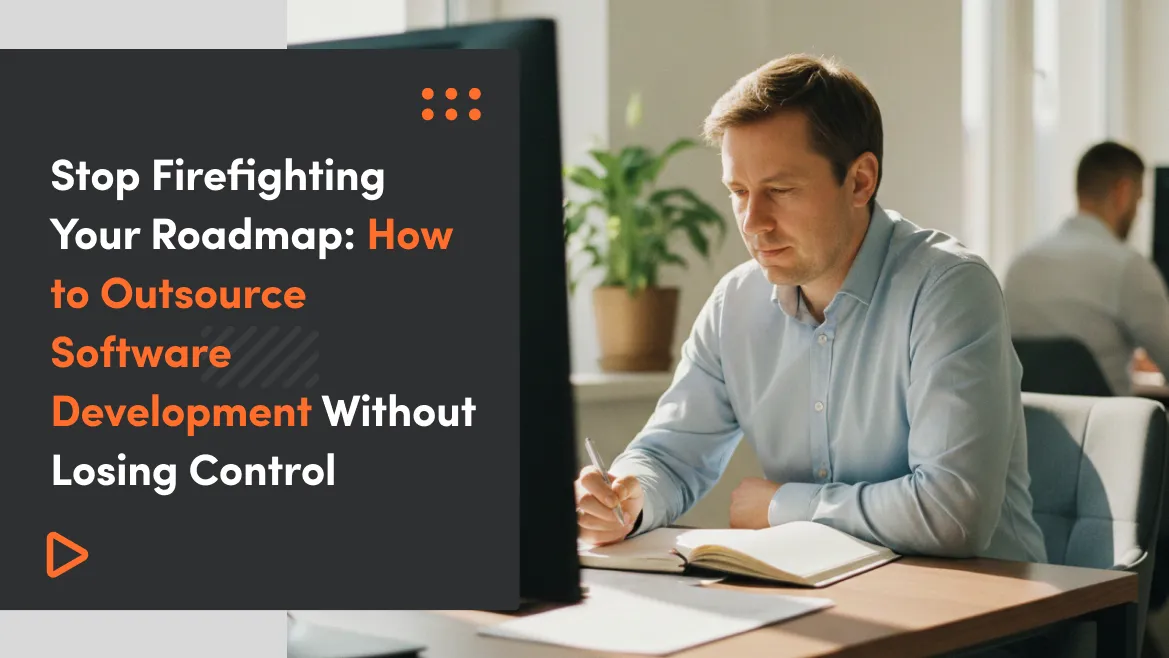Do you remember the famous catchphrase from the 1989 baseball movie "Field of Dreams" as the lead character was told, "If you build it, they will come"?
Similarly, an RFP is a document businesses use to advertise a new project offer and invite interested parties to a competitive bidding process. It's susceptible to change and is time-sensitive. We have over 15 years of experience in creating requests for proposals and discussing the most intricate details of projects with our clients, so we surely have some tips for you.
In this article, you will get to read all about RFPs and formulate one that is beneficial for your organization.
What is an RFP, and When do you Need One?
The term RFP refers to a request for proposal. An RFP is a document that outlines all of a project's criteria and demands. It assists businesses in preparing for forthcoming projects by serving as a proposal to prospective contractors and agencies.
An RFP can be used for any one of the following three reasons:
- When a best-suited vendor is needed for your organization.
- When accountability and good governance are required.
- When your business needs a good assessment of the opportunity.
Types of RFP Requests
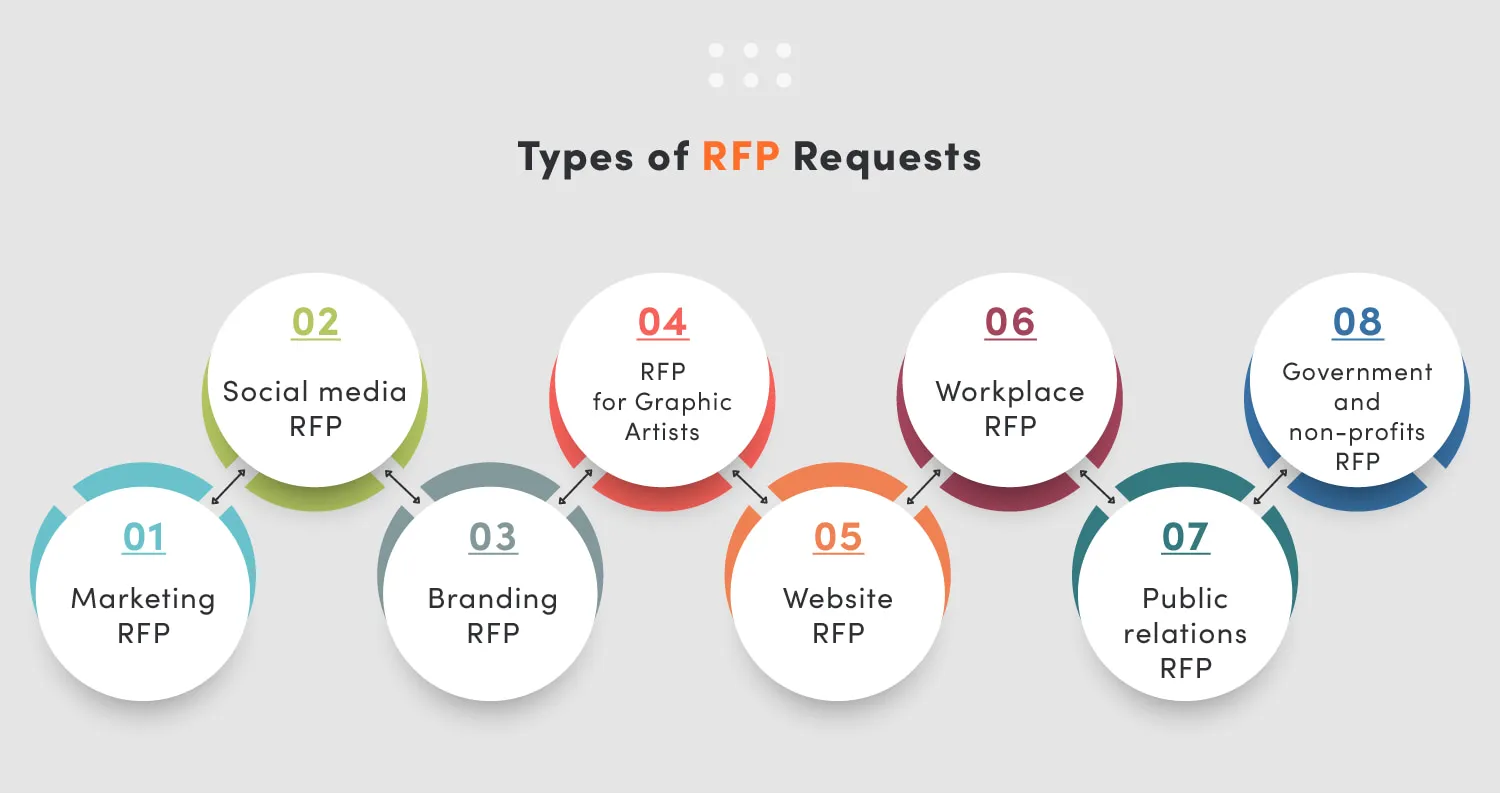
Following are the different types of RFPs:
- Marketing RFP: A marketing RFP is a request for proposals (RFP) for assistance in developing marketing materials such as case studies and eBooks.
- Social media RFP: The purpose of the Social Media RFP is to assist social media marketing or management companies in showcasing and increasing brand awareness on social media networks such as LinkedIn.
- Branding RFP: A branding RFP is a request for proposals from branding firms to assist your company in developing brand standards and expectations. Branding content like logos and bespoke slide presentations may also be created with the aid of agencies.
- RFP for Graphic Artists: This RFP is seeking graphic artists to assist in upgrading websites or the production of visual assets.
- Website RFP: A website RFP is a request for proposals for web developers to supervise the development or upgrade of a website.
- Workplace RFP: The RFP for Workplace is for senior management to bring in technology to assist offices in increasing the performance on behalf of employees.
- Public relations RFP: This is for a public relations agency with a news release plan of action and trademark protection.
- Government and non-profits RFP: Government and non-profit RFP is for government agencies or non-profits hiring outside groups to help them with projects like domestic social betterment or international gender relations.
Benefits of RFP
An RFP is a hybrid of a request for proposal and an advertisement. It informs the public that a project is underway and invites eligible persons to apply.
The government has used the RFP to ensure that favoritism is not a factor in contract awarding. It also invites competition into the process, which should help keep project prices down.
A less formal procedure that requires a project manager to conduct research and identify possible providers for a project is a substitute for an RFP. The number of possible replies might vary depending on how thorough the search is. New providers and creative solutions may go unnoticed.
- helps meet the organizational need
- provide transparency and accountability
- help ensure project success
Key players in the RFP Workflow
An employee can request a proposal to advocate for themselves, their team, and their needs. As a result, the RFP should be developed by the project's main stakeholders.
The individual or team preparing the RFP should be familiar with the project and capable of making decisions. Selecting a vendor to execute the project is an element of the RFP process, and only those who are invested in its success can make the best selection.
- Consultant
- Procurement professional
- Business stakeholders
- CFO
Try our developers.
Free for 2 weeks.
No risk. Just results. Get a feel for our process, speed, and quality — work with our developers for a trial sprint and see why global companies choose Selleo.
Other RFCs you should Know
Request for proposal (RFP), request for information (RFI), request for quote (RFQ), request for tender (RFT), and other "request" papers in the procurement process are all referred to as "RFx." It denotes a request for x.

Request for information
A request for information, often known as an RFI, is a document that assists companies or teams who want further information about a proposal before deciding what to search for. It's also known as an expression of interest (EOI).
RFI is a document with open-ended questions to talk about the full range of offerings.
Request for proposal
It's time to send out those RFPs once you've gotten all of the information you require. RFOs, or requests for offers, are another name for them. Don't be confused If you find the two interchanged throughout your research or solicitation process.
RFP is a document to ask vendors to propose solutions to your problems. It contains much more specific information and requirements. The key is to give vendors the context in order for them to propose a valid solution.
Request for quote
If the only thing preventing you from employing a vendor is the cost, send a request for a quote (RFQ). This is a paper that states: "I know exactly what I want. I've decided to put money into this initiative. All I need to know is how much you would charge for it."
RFQ states the exact specifications required by the company and it provides less flexibility to the vendor to suggest a solution. They often contain a table that lists each requirement and asks the vendor to assess its ability to fulfill that request.
Request for tender
A request for tender, also known as an invitation to tender, is more commonly used for government projects or proposals. An RFT is similar to an RFQ in that it demonstrates that a stakeholder is confident in their choice to acquire goods and services.
Which one is the best for you?
It’s hard to clearly choose one or the other. Some vendors prefer the RFI-RFP route to an RFQ since the latter gives you a rather closed approach. It can sometimes limit creativity and can signal that you don’t want to learn anything new and aren’t open to new approaches. This makes the RFQ more appropriate for projects where you augment an existing system.
What does the RFP process look like step by step?
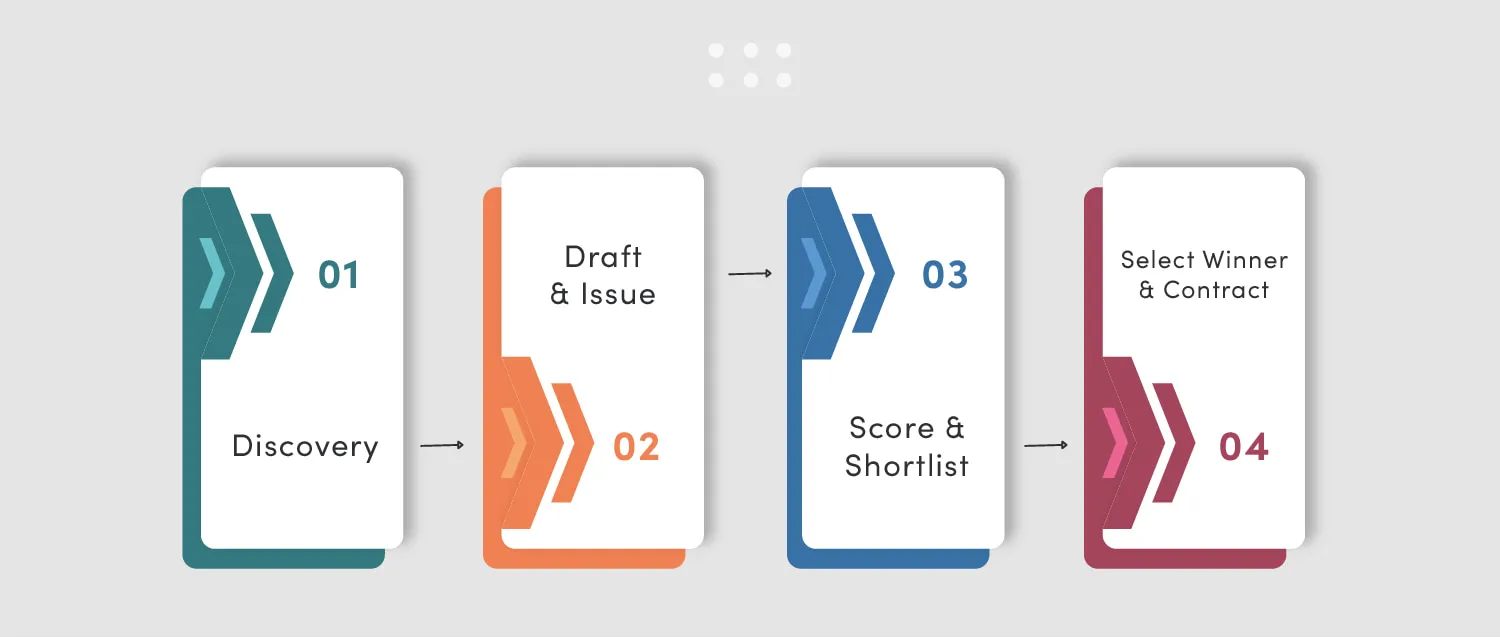
Here are the best-recommended steps that ensure best practices.
Discovery
- Determine which purchase decision will impact important stakeholders.
- Schedule a meeting with your internal team to discuss both broad and particular business goals, as well as a budget.
- Make a list of questions for the team.
- Allow for a collaborative review and modification process of this document by documenting the team's replies.
Draft and Issue
- Make a list of precise and focused questions to ask. Is there a neutral template that can be used as a starting point?
- Add open-ended questions to your survey.
- Ascertain that vendors are aware that their replies will be compared to those of other vendors.
- Vendors and internal stakeholders should be given clear deadlines.
- Answer any queries vendors may have concerning the questionnaire and/or criteria.
Score and Shortlist
- Assess and grade supplier replies with the help of stakeholders and appropriate sourcing specialists.
- Reject the proposal for vendors that do not meet deal-breaking criteria.
- Define clear identifiers and strengths to shortlist vendors based on high scores.
Choose the Winner and Sign the Contract
- Before making a choice, don't be scared to inquire about more demos or meetings.
- Make sure to read all of the reviews and get in touch with any references.
- Negotiate with the top contenders to get a contract with your preferred provider.
- Notify the non-winners and explain why they were not chosen.
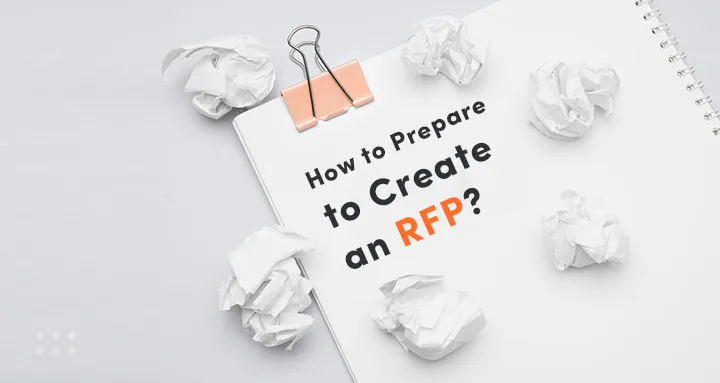
How to prepare to create an RFP?
If you want to receive positive attention and feedback, follow these six crucial steps before submitting the RFP.
Select the right team
A single individual or a group of people can create an RFP. The type of your business, project, and budget will determine this. If your company has ten employees, you don't want 7 of your ten employees to spend days on this file. If you have a big company, though, you may want to enlist the help of an entire team to manage the quality of your RFP.
Employees from other departments may also be involved in document generation. While the marketing department may be in charge of a project, it can also influence sales and development.
Determine goals and measurements of success
If you don't know how to assess the project's success, don't create an RFP. Approaching company endeavors without defined objectives or goals is a great way to squander your time and money.
Even a seemingly small job like repairing your office's floors should have well-defined objectives, such as finishing the project on time and within budget.
Determine project requirements
The requirements of a project are the particular procedures or expectations that will assist your business in achieving its objectives.
Assume you contact a design studio to revamp your website. Do you have a website platform in mind, or will they have to select one for you? Will you supply the design equipment for them, or will they have to bring their own?
Build a timeline
Unless you have a precise and rigorous deadline, planning, drafting, and delivering RFPs can take an eternity. The creation of a timeline necessitates communication between two distinct entities.
The stakeholders prepare the RFP, and the vendors are expected to reply with their recommendations. Failure to set precise, reasonable expectations and proposal deadlines can cause the process to drag on needlessly.
Know your budget
While budget may not be the first topic on your mind when speaking with a provider, it will come up eventually. It's your responsibility to stay up to date on industry best practices and what your company has to offer. This will ensure you are neither under nor overpaid and can seal the deal with the perfect candidate.
Determine your wants vs. needs
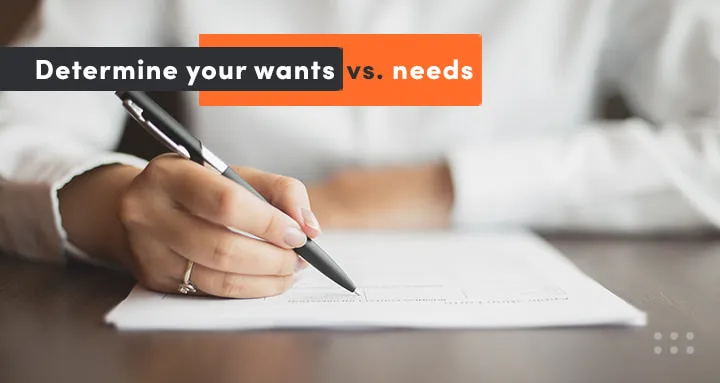
This stage is crucial in determining your budget. Consider the case of an office that is remodeling its floor. For years, the company's floors have been carpeted, but it is now exploring hardwood. They choose hardwood flooring because it has a more refined appearance and can impress guests. On the other hand, this company is always moving furniture, rolling marketing items about, and receiving big deliveries on dollies.
How long should an RFP be?
The best approach is to ensure that all stakeholders are included and collaborate with the sourcing team.
Generally, there are one or more stakeholder conferences — in person or online — when the stakeholders' particular demands are identified and the assessment criteria are developed. This pre-RFP procedure is crucial because it determines the scope and duration of the RFP questionnaire. In reality, issuing and scoring the RFP could be thought of as the climax of a process of understanding and documenting the needs for a product or service. The RFP should be...well, as long as it is required to be.
Granted, the preceding is most likely a rather unsatisfactory response! In our experience, the majority of RFPs, the number of questions varies from 50 to 200.
Top elements of a good RFP
Some typical categories to include in an RFP are:
Background
Include any background information about your company and its history that you believe is vital for potential contractors to know in your intro, such as:
• When and by whom was the business
• When and by whom was the business founded?
• Where are you located?
• What services or products do you offer?
• What sets you apart from your competitors?
Project overview and goals
You should include:
- All of the business objectives you want to achieve as a result of the project
- An overview of any specific criteria or activities that may be required.
Outline what you believe to be contract-winning services, such as:
Scope of work
If you're seeking particular systems, equipment, materials, or goods, you'll need to include a checklist, so suppliers know exactly what you're looking for.
Because the RFP is your document, you may include precisely what you require.
Deadlines and milestones
You can instantly exclude any vendor who can't meet those dates by giving a precise timeline in your RFP, saving you (and them) a lot of problems along the road. If your project requires some flexibility, you may state it in your proposal, saying that you are willing to negotiate with the correct applicant.
Questions or materials
This is a fantastic element to add to your presentation. Make a list of documents you'd like the potential vendor to provide, such as:
- Their estimated pricing of services
- Samples of previous work
- Proof of technical ability to execute your project
- Proven success with other organizations or projects
You may also use this area to ask particular queries that you'd want suppliers to respond to in their RFP submissions.
Evaluation criteria
If you decide to utilize weighted scoring, it will also be crucial to include this. For example, your weighted scoring might be:
- 30% of your decision is based on the cost estimate
- 35% on technical requirements
- 10% on approach
- 15% on management
- 10% on innovation

Possible roadblocks
Although these barriers will vary considerably based on the sector and organization, you—and your outsourced vendor—might have to deal with things like obsolete plan forms, customized code, and restricted resources, to name a few.
Guidelines for submitting the proposal
Candidates will learn a lot of vital information in this area, such as Where they can access the RFP
- When the RFP can be accessed or downloaded, it can be accessed
- How many copies they should include
- Who they should submit it to
- How it should be marked
- The final deadline for receiving RFPs
What is the RFP timeline?
Your RFP should contain a few different deadlines. Here are some important RFP dates to pre-share with vendors:
- Proposal deadline: This is the deadline by which suppliers must examine and respond to proposals.
- Evaluation window: A period during which stakeholders examine ideas throughout the evaluation process. During this time, vendors should be aware that no decisions have been taken. This is also a timetable during which stakeholders can contact suppliers for further data if they don't have all they need to decide.
- Selection deadline: The selection deadline is when suppliers are notified whether or not they have been successful in obtaining the project's responsibility.
- Negotiation deadline: Back-and-forth negotiations might take a long period. Instead of a day, set a deadline. Send your initial draught contract to the chosen supplier as soon as feasible, and inform them of the deadline for completion.
- Deadline for notifying unselected bidders: This is a timeframe that all parties involved should comply to. If you don't notify the suppliers on the specified date, you may receive a barrage of phone calls and emails asking for your final choice.
- Timeline for project completion: According to the stakeholders, these are the dates on which the project's activities are expected to take place. This timeline can include different phases: Setup, initiation, planning, and completion.
Sample RFP Questions you can use
The purpose of an RFP is to simplify the selection process of an integral part of services, vendors, or stakeholders for your organization. There are a few sample questions you can use to formulate an RFP.
Questions to ask yourself before you begin
First, you need to evaluate whether you are on the right foot to start, and here are some questions you should ask yourself.
- Are you ready for an RFP?
- Who will fulfill the duties of project lead or procurement manager?
- Which teams will be dedicated as evaluators along with other stakeholders?
Questions for your team and stakeholders
Now you are one step closer to creating an RFP. However, before asking a question from vendors and third parties, you need to ask your teammates and stakeholders a few questions. This internal discussion is to identify the critical needs and requirements. Here are some questions you should consider:
- What are your financial expectations in terms of budget?
- What goals and aims are set for the project?
- What are the crucial deal-breaker factors?
Here are some examples of common deal-breakers:
- Critical audit findings
- Failure to meet security standards
- Lack of defined policies or procedures
- Inability to meet budget or timeline requirements
- Use of sub-contractors
- Customer support concerns (outsourced, language barrier, etc.)
- Lack of client references
- Custom development required
- What factor of service or product is more critical to the deal?
- Will the RFP be a multi-step process?
- What will be your evaluation and scoring factors and processes?
Questions to ask your vendors
Finally, you are at the stage to start putting RFP questions for vendors. Use all the details you have gathered from the internal discussion and self-evaluation. The best way is to ask a mixture of open-ended and closed-ended questions from vendors. You should include questions based on stakeholder feedback as well as industry-specific questions.
Here are some sample questions to ask from vendors.
- What would you bring to the table, and why should I select you?
- What qualifications do you have for this industry and our company?
- Which workers of the team would be willing to assist us with this project?
- Can we contact references for case studies that are related to our use case?
- Who is your main competition?
- How can your customer success team assist us in achieving our objectives?
- How will you safeguard our company from damage?
Key questions to ask in an RFP
Here are the key questions that should be part of the RFP document.
Is there any free trial available?
A free trial helps you get a clear picture of the vendor and what they have to do with no risk to your organization.
What is your implementation process?
Setting it up is the most critical part of the process when it comes to software or hardware. To maximize the effectiveness, RFP issuers should understand how long it will take to implement and how many vendors will be involved.
How much training will the vendor conduct?
A clear understanding of the software or system is highly demanded which vendor should conduct training. It is also essential to understand the features and functionality of the product or the service.
How does the vendor handle customer support?
After-sales services are critical, especially for technological products and services. Check the option available at vendors to contact them in case of emergencies and queries.
How to properly evaluate the responses?
Assessment is difficult. You want to make the most of your employees' or team's time while also ensuring that every proposal is thoroughly evaluated. You can utilize the assessment techniques listed below to speed up the process.
The split up
You can ask your team to split the work and accept a few bids at a time if they have uniform criteria and everyone understands what a good proposal looks like.
You can convene a meeting in which each employee expresses their support for or opposition to the recommendations they've considered, giving the rest of the team a sense of what's been offered.
Multiple eyes

This technique works well for businesses that have a restricted number of options. For optimal exposure, have each team member examine each request and write notes on their thoughts. This is the most time-consuming approach, but it assures that everyone with decision-making authority sees every idea.
Share and score
Team members are given portions of each proposal to review and evaluate using this method. A team member, for example, may be assigned to rate each "experience" component. If there are five recommendations to consider, each of the five experience parts is evaluated, and a record is kept for each.
Shortlisting
A shortlist is a whittled-down group of bidders that your company has determined is appropriate for further consideration or negotiation in the RFP process.
Shortlists are generated after an RFI is submitted in certain cases and after the review or assessment process is completed in other cases.
You can choose which applicants you wish to evaluate further once your team has thoroughly reviewed all applications. These are your contact points or your shortlist.
Negotiations
You may have limited your options to two bidders, but you want to see if you can get a better price or a better timetable. This will be one of your final opportunities to do so. When you choose a bidder, you're indicating that you're satisfied with many of the specifics in their offer.
Responses
You and your bidders have worked hard and deserve a courteous and, if possible, customized rejection!
Here are some pointers on how to easily let down unsuccessful bidders whose services you might need in the future:
- Send emails individually. This is not the time to begin sending out mass emails. Sending a personalized email would show bidders that you cared about their offers.
- Use names. Your involvement in that candidate and process becomes much more evident when you address the email with a company, or better still, a person's name. While sections of the email can be template responses, adding a name or two takes a few seconds.
- Reiterate your thanks. The bidders have spent hours, if not weeks, preparing and conveying a proposal to you. Make an effort to avoid seeming generic or mechanical. Let the bidders know how much you value their efforts and hard work.
Biggest Challenges in the RFP Workflow
Below are the top 3 challenges for many organizations:
A Time-Consuming Process
Even the prospect of combing through email chains and spreadsheets in search of answers may impose a lot of stress on a team working under a tight deadline. It is important to think about the time it takes to:
- Gather and arrange vendor answers for distribution and evaluation to stakeholders.
- To make an accurate comparison, combine all of the vendor information.
- Determine which vendors have yet to begin their response and follow up with them to ensure that deadlines are met.
- Examine the attachments that suppliers attach to their answers.
- Obtain input from the organization's internal stakeholders.
Stakeholder Involvement
The RFP process should be viewed as an opportunity rather than a requirement. To improve stakeholder involvement, companies should: Recognize the importance of openness throughout the whole process. Without the appropriate technology, this may be extremely difficult. Features like deadline reminders, job assignments, and notifications are included in automation systems to keep the process on track and promote active involvement.
ROI
Do you know how much money your company spends on the procurement process? More and more businesses are recognizing the importance of cost savings to their bottom lines. Due to hurrying to meet deadlines, manual RFP processes result in copy-and-paste mistakes when attempting to combine documents. Organizations make decisions and judgments based on inadequate data or ill-defined objectives.
Read also: [How Can Your Business Win With Team Augmentation?](How Can Your Business Win With Team Augmentation?)
Best Practices and Tips to Develop RFPs
Here are five RFP expert tips and best practices for beginners:
Tip # 1: Know the difference between RFP, RFQ, and RFI
We have already explained in detail the difference between an RFP, RFQ, and RFI. You should be clear about your requirements and needs to select the best option for your organization.
Tip # 2: Don't forget to build relationships
To compete in the market with an edge over other companies, building a relationship with your vendors is essential. Your vendor defines your product; any change in the quality and quantity can make you lose your customers.
Tip # 3: Be prepared to define RFP objectives accurately
An RFP without a clear goal and objective is just a piece of useless paper. You need to describe what you're trying to reach through this RFP and your actual requirements to differentiate between vendors and partners.
Tip # 4: Review the RFP requirements
Once the RFP is created, the first thing you need to do is scan all the requirements. It will help you to reduce the time of reviewing unwanted RFPs.
Tip # 5: Communicate and automate RFP
Communication and automation of the RFP are the keys to success. Communication keeps things clear during the process, and automation saves time.
Are you ready for your first RFP?
Until now, we've covered a lot of ground together. You studied the basics of RFPs, the different types of RFPs, how to write an RFP, how to distribute an RFP, and how to score a response to an RFP.
A once-difficult RFP process has become more simple and accessible. There's no reason it should be frightening or difficult any longer. So, go ahead and start working on your first RFP.
**Gain a new perspective on your team and clients during the RFP process with Selleo experts. We believe in delivering the best. **Contact us now!



